|
Tradition,
Tradition, Tradition
by Bob Brooke
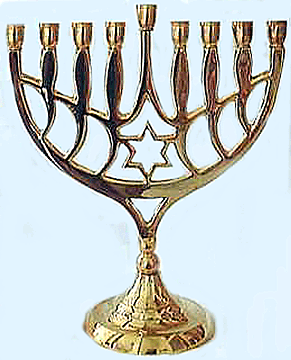 While
many people around the world prepare to celebrate the birth of Jesus at
Christmas this month, Jews are preparing to celebrate their annual
festival of Chanukah—the Festival of Lights—which, this year, coincides
with the Christmas season. But that’s where the similarity ends. While
many people around the world prepare to celebrate the birth of Jesus at
Christmas this month, Jews are preparing to celebrate their annual
festival of Chanukah—the Festival of Lights—which, this year, coincides
with the Christmas season. But that’s where the similarity ends.
Celebrations such as Chanukah and Passover are steeped in tradition and
unlike Christian holidays, have been celebrated for over 2,000 years.
Traditions as old as these breed craftsmenship, and it’s that fine
craftsmanship that collectors of Judaica seek today.
“For Jews, this is especially so when the art in question is usable not
only as decoration, but also as ritual object, art linked to practice,”
said J. F. Thorsteinsson, owner of Scandia Antiques of Ottawa, Canada.
“Non-Jews are attracted to Judaica because of its beauty and exotic
nature, and by the symbolism and rich diversity of Jewish art.” Both
types of collectors have discovered that collectible Jewish art objects
exist which aren’t only beautiful, but also express Judaism's rich
religious, cultural, and artistic heritage.
But unlike most Christian antiques, craftsmen created Jewish ceremonial
art to be used mostly in the home. Along with majestic Torah ornaments
and sumptuous textiles of splendor and beauty in the synagogue, there
are Chanukah lamps of bronze and silver, beautiful illuminated Ketubot
or marriage contracts, and illustrated Passover Haggadot.
Chanukah and Passover
The most widely known Jewish holidays are Chanukah and Passover. Every
year between the end of November and the end of December, Jewish people
around the world celebrate the holiday of Chanukah, the Festival of
Lights. Chanukah begins on the 25th day of the Hebrew month of Kislev,
but the starting date on the western calendar varies from year to year.
The holiday celebrates a miracle which took place over 2,300 years ago
in the land of Judea, which is now Israel.
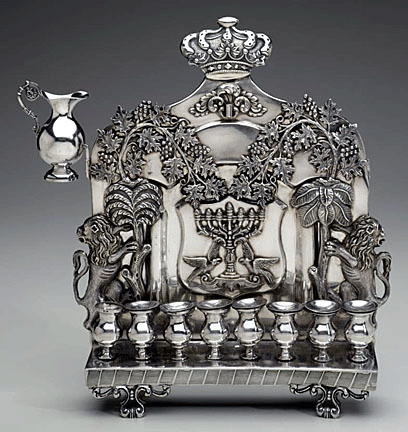 Chanukah,
Hanukah or Hanukka—they all mean the same when translated from Hebrew.
As the story goes in the Book of Maccabees, the miracle occurred during
the rule of Antiochus, a Syrian king and successor to Alexander the
Great. A small band of Jews, led by Judah Maccabee and his brothers, had
retaken the Temple in Jerusalem after defeating the Syrians and wanted
to rededicate it and light the Temple’s seven-branch Menorah, a type of
candelabra known as the N’er Tamid, or eternal light. Unfortunately, the
supply of sanctified oil for the lamps had been tainted by the Syrians,
and there was only enough for one night. After filling and lighting, the
lamp burned for eight nights, the time it took to prepare newly
sanctified oil. The Festival of the Lights, or Chanukah, which means
“rededication,” lasts for eight days to commemorate the miracle of the
oil. Chanukah,
Hanukah or Hanukka—they all mean the same when translated from Hebrew.
As the story goes in the Book of Maccabees, the miracle occurred during
the rule of Antiochus, a Syrian king and successor to Alexander the
Great. A small band of Jews, led by Judah Maccabee and his brothers, had
retaken the Temple in Jerusalem after defeating the Syrians and wanted
to rededicate it and light the Temple’s seven-branch Menorah, a type of
candelabra known as the N’er Tamid, or eternal light. Unfortunately, the
supply of sanctified oil for the lamps had been tainted by the Syrians,
and there was only enough for one night. After filling and lighting, the
lamp burned for eight nights, the time it took to prepare newly
sanctified oil. The Festival of the Lights, or Chanukah, which means
“rededication,” lasts for eight days to commemorate the miracle of the
oil.
In America, many Jews decorate their houses, entertain friends and
family, and give and receive gifts, as well as light the menorah.
However, many non-Jews don’t know that Chanukah isn’t an important
Jewish festival. According to Rabbi Yehudah Prero of Project Genesis,
unlike the other Rabbinically ordained observances, Chanakah isn’t
mentioned explicitly at all in Jewish Scripture.
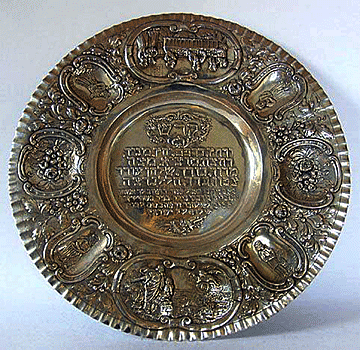 Passover
is the pre-eminent Jewish holiday which commemorates the redemption from
slavery and the exodus from Egypt. The story, read from the Haggadah at
the Seder, tells of the time when the Angel of Death rushed through
Egypt, where the Jews were held in sorrowful bondage. Death was on a
God-sent mission against the first-born children in the land, but would
"pass over" the door of the houses that bore the blood of a newly slain
lamb. After being freed, the Jews began their 40-year trek across the
deserts between Egypt and their homeland. Passover
is the pre-eminent Jewish holiday which commemorates the redemption from
slavery and the exodus from Egypt. The story, read from the Haggadah at
the Seder, tells of the time when the Angel of Death rushed through
Egypt, where the Jews were held in sorrowful bondage. Death was on a
God-sent mission against the first-born children in the land, but would
"pass over" the door of the houses that bore the blood of a newly slain
lamb. After being freed, the Jews began their 40-year trek across the
deserts between Egypt and their homeland.
Passover, which begins with two special holiday dinners and ends with a
final celebration, is another eight-day holiday. Jews call these festive
meals "Seders,” at which it’s a tradition to re-tell the story of the
Exodus from Egypt.
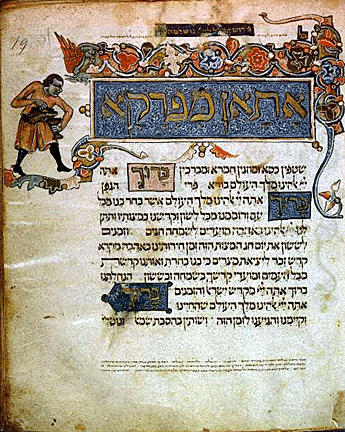 Before
Passover begins, the wife and children of the family traditionally
thoroughly clean the house, searching high and low to remove any crumbs
of leavened bread—bread that was made with a rising ingredient such as
yeast. During Passover, only unleavened bread can be eaten. Before
Passover begins, the wife and children of the family traditionally
thoroughly clean the house, searching high and low to remove any crumbs
of leavened bread—bread that was made with a rising ingredient such as
yeast. During Passover, only unleavened bread can be eaten.
At the Passover Seder, there’s generally a ceremony involving unleavened
bread and bitter herbs. The youngest and the eldest at the table recite
the questions from a Haggadah and remind those seated around the table
of the answers, which commemorate the Jews escape from bondage and into
Deliverance. Jews set a separate place at the table, with its own glass
of wine, for the prophet Elijah, who will eventually herald the coming
of the Messiah.
Judaica Collectibles
 Each
of these holidays has its own collectibles. The ultimate Chanukah toy is
the dreidel, a four-sided top, first made in German of wood, lead or
pewter, with different Hebrew letters—Shin, Hey, Gimel, Nun—on each
side, standing for the Hebrew phrase Nes Gadol Hayah Sham, which
translates as "A Great Miracle Happened There." Children spin the top,
and each fall of the top is supposed to remind them of the fall of their
enemies. Thus a child playing with a dreidel also receives a history
lesson, while playing a betting game for the pennies, nuts, raisins, or
gold foil-covered chocolate coins used as tokens. Each
of these holidays has its own collectibles. The ultimate Chanukah toy is
the dreidel, a four-sided top, first made in German of wood, lead or
pewter, with different Hebrew letters—Shin, Hey, Gimel, Nun—on each
side, standing for the Hebrew phrase Nes Gadol Hayah Sham, which
translates as "A Great Miracle Happened There." Children spin the top,
and each fall of the top is supposed to remind them of the fall of their
enemies. Thus a child playing with a dreidel also receives a history
lesson, while playing a betting game for the pennies, nuts, raisins, or
gold foil-covered chocolate coins used as tokens.
Craftsmen have created menorahs, the candelabras that hold the eight
Chanukah candles, in a variety of designs. While most Jews prefer plain
ones, there are elaborate menorahs that reflect the style of the times
in which they were made.
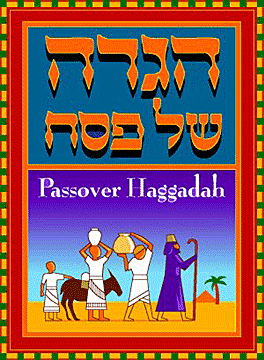 Collectibles
are plentiful in any holiday that relies on continuing tradition, and
this is certainly true of Passover, for which the prime collectible is
the Haggadah, the book from which Jews read passages at the Seder.
Essentially, the Haggadah guides the rituals and narrates the story.
Often illustrated, sometimes bound in silver embellished covers, some
sell for several hundred dollars. Collectibles
are plentiful in any holiday that relies on continuing tradition, and
this is certainly true of Passover, for which the prime collectible is
the Haggadah, the book from which Jews read passages at the Seder.
Essentially, the Haggadah guides the rituals and narrates the story.
Often illustrated, sometimes bound in silver embellished covers, some
sell for several hundred dollars.
At the center of the Seder table rests the Passover Seder plate, used to
arrange the traditional ingredients–the shank bone, symbolizing the
strong hand in outstretched arm with which God redeemed the Israelites
from bondage; the roasted egg, symbolizing fertility and continuity; the
bitter herbs (usually horseradish), symbolizing the bitterness of
slavery; the parsley, symbolizing spring and rebirth, and the charoset,
a
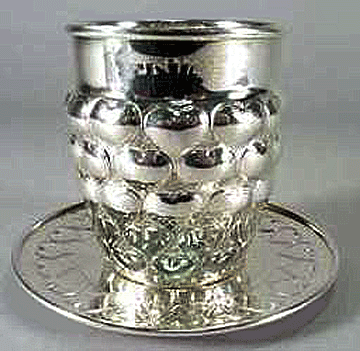 mixture
of apples, nuts, cinnamon, and wine, symbolizing the mortar with which
Jewish ancestors in Egypt laid bricks. In addition, some Jews use a
special Passover Kiddish cup to hold the ceremonial wine. mixture
of apples, nuts, cinnamon, and wine, symbolizing the mortar with which
Jewish ancestors in Egypt laid bricks. In addition, some Jews use a
special Passover Kiddish cup to hold the ceremonial wine.
Special tablecloths, a special yamika—the skull cap worn by men during
prayer—children’s Passover story books, special songbooks, and holiday
kitchen mitts are all items to add to a Judaica collection.
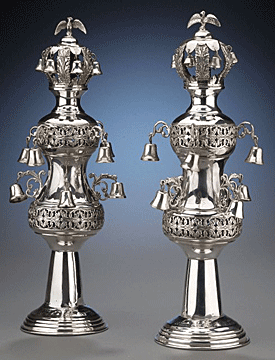 While
the most common items of Judaica are menorahs, dreidels and seder
plates, collectors also acquire spice containers and various textiles.
Jewish textiles and embroideries come in a variety of styles and sizes,
including Torah ark curtains, Torah mantles, Sabbath and festival Hallah
(bread) covers, and Passover matzah covers, as well as embroidered hand
towels, circumcision pillows and garments, bridal and other ethnic
women's head coverings and folk costumes of various kinds. While
the most common items of Judaica are menorahs, dreidels and seder
plates, collectors also acquire spice containers and various textiles.
Jewish textiles and embroideries come in a variety of styles and sizes,
including Torah ark curtains, Torah mantles, Sabbath and festival Hallah
(bread) covers, and Passover matzah covers, as well as embroidered hand
towels, circumcision pillows and garments, bridal and other ethnic
women's head coverings and folk costumes of various kinds.
“The most interesting of all Jewish textiles is the Wimpel,” said
Thorsteinsson. “originally a swaddling cloth wrapped around a baby boy
at his circumcision, which was then washed and cut into strips which
were sewn together to form a long, narrow strip of cloth. On the Wimpel
was then written the boy's name, the father's name—and often the family
name—the day of the week, day of the month and day of the year in which
he was born and, of ten, the place, followed by the blessing that he
grow up to the study of Torah, to the marriage canopy and to a life
defined by performing acts of loving- kindness for others. Upon the boy
being weaned, he was ceremoniously carried into the synagogue where he
presented his Wimpel, and it was then wrapped around a Torah scroll and
thereafter employed as a Torah binder in the synagogue.”
Thorsteinsson noted that Wimpel makers often wrote the Hebrew text in
ornate medieval calligraphic letters. Usually colorfully painted and
occasionally embroidered, old Wimpels are at times embellished with
whimsical, folkloric pictures and are easy to date, since the text
always contains the exact date.
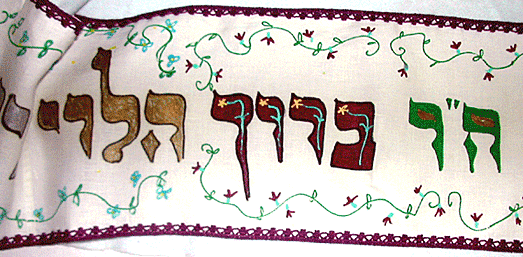
Decorated marriage documents, or Ketubot, are highly prized by
collectors, especially those with unique Hebrew calligraphy. They’re
readily identified and dated, since all contain the name of the original
owner, location and date of the marriage.
< Back
to Collectibles Archives
Next Article > |
